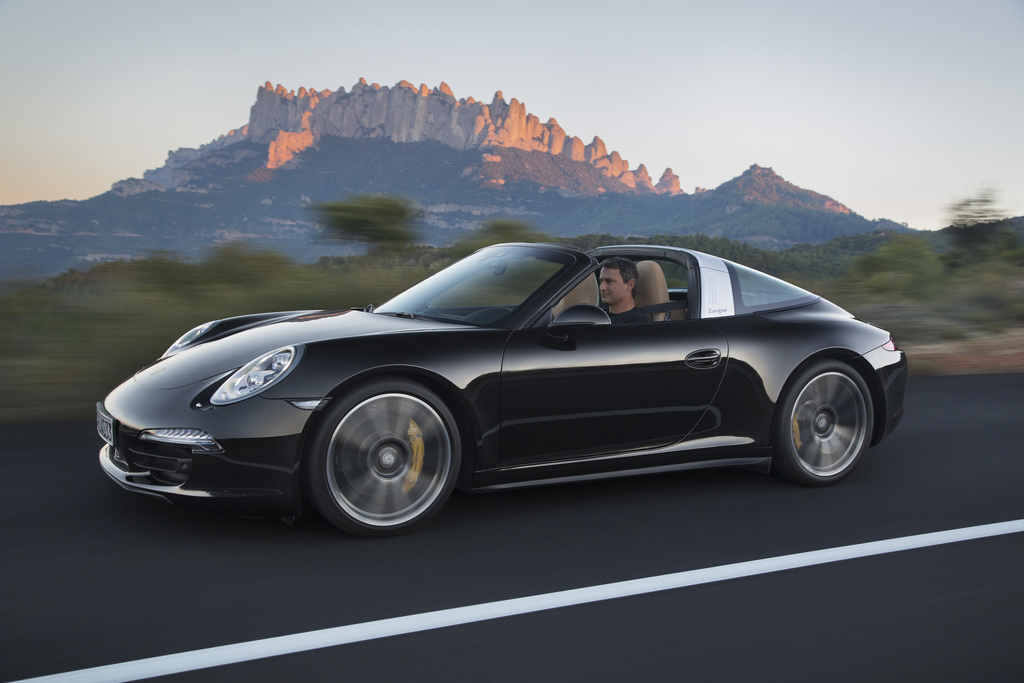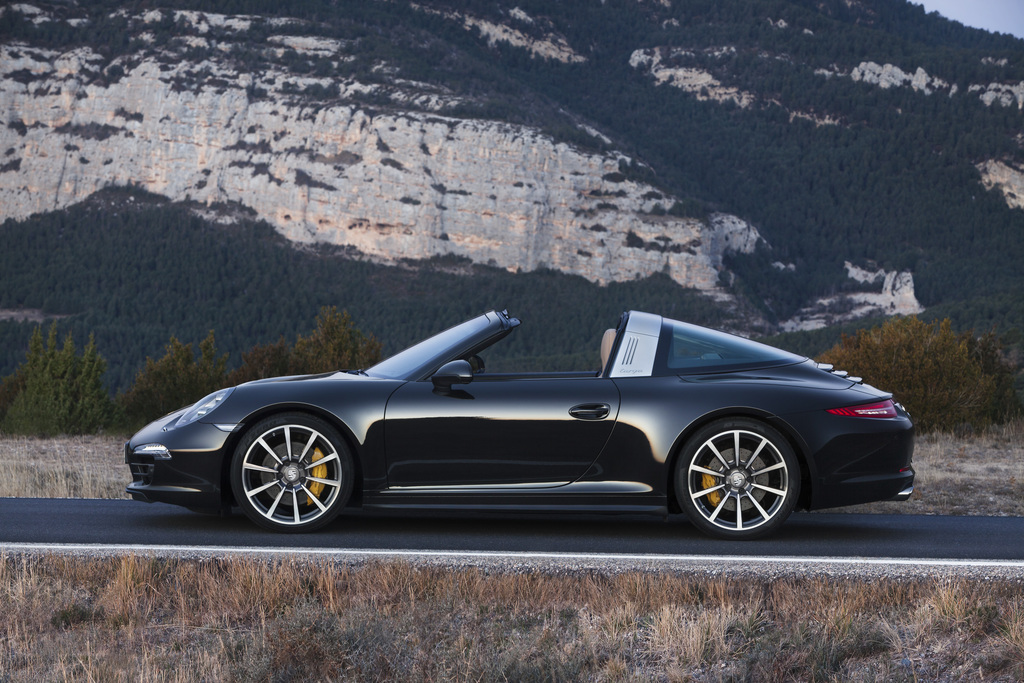(2014 – 2015) Porsche 911 Targa 4S (991) – Ultimate Guide
The 993-generation Targa 911 brought with it the first incarnation of the sliding-glass roofed “Targa,” which never caught on like the original, removable vinyl-trimmed versions, the true Targas. Porsche continued with this design for the 996 Targa and 997 Targa generation cars too. Thankfully, for the 991 generation Targa 4 and Targa 4S, Porsche went back to the classic targa design.
Just like the legendary original Targa model, the new model features the characteristic wide bar in place of the B-pillars, a movable roof section above the front seats and a wraparound rear window with no C-pillar. But unlike the classic models, the roof segment on the new Targa can be opened and closed at the push of a button. You can activate the roof from the key fob: the huge goldfish bowl rear window hinges up, the hard fabric roof panel flips back and folds away, then the glass canopy drops again – while the metallic rollover hoop remains fixed in place. It’s an 18 second process that is very theatrical.
The Targa 4S gets comes only in all-wheel drive, which frankly makes sense given that this is an all-weather car for those in colder climates who want to enjoy open top driving in the warmer months without the compromises to winter driving. This 911 Targa 4S offers optimum driving dynamics on all road surfaces and in all weather conditions.
Car Magazine: For many it will offer the perfect halfway house between the coupe and convertible – and the icing on the cake is how it mixes regular Carrera 4S go with a sense of style and everyday usability (those occasional rear seats, the real possibility of 30mpg in everyday driving). We were converted.
The 911 Targa 4S gets the same engine as the other Carrera S models. It delivers 400 hp (294 kW) from a displacement of 3.8 litres. This model reaches a top speed of 296 km/h and, with the PDK and Sport Chrono package fitted, accelerates in 4.4 seconds. Its fuel consumption fluctuates between 10.0 and 9.2 litres per 100 km, depending on transmission, which corresponds to a CO2 level of between 237 and 214 g/km. With these figures, the model is on a par with the high standard set by the 911 Carrera 4 cabriolet models in terms of engine and road performance, as well as efficiency.
It is important to note that the Targa 4S is “softer” than the Carerra 4S and Carrera 4S Cabriolet:
Autoweek: it’s almost 100 pounds heavier than a 911 Carrera 4S cabriolet — and significantly 350 pounds heavier than a rear-drive Carrera S coupe… Porsche admits the coupe’s chassis is twice as stiff, too, but revised spring and damper rates and reasonably smooth roads don’t convey a wildly different driving experience. It’s pure 911 in cruise mode, and — subjective, yes — a damn good-looking car, especially in profile.
Pictures
Press Release
Featuring the innovative Targa roof: The world premiere of a modern classic (13/01/2014)
World premiere of the 911 Targa: At the North American International Auto Show (NAIAS) in Detroit, Porsche is presenting the latest generation of the extravagant 911 model to the public. This model is the first to combine the classic Targa concept with state-of-the-art roof technology.
Just like the legendary original Targa model, the new model features the characteristic wide bar in place of the B-pillars, a movable roof section above the front seats and a wraparound rear window with no Cpillar. But unlike the classic models, the roof segment on the new Targa can be opened and closed at the push of a button. When the button is actuated, the fully automatic roof system stows the convertible top behind the rear seat system, providing a real spectacle. The rear-weighted design of the PTM all-wheel drive fitted as standard is a typical Porsche feature, and guarantees that this latest 911 model also offers optimum driving dynamics on all road surfaces and in all weather conditions.
With these features, the new 911 Targa is presenting itself as a high-quality, innovative remake of the classic vehicle from 1965. The model shares a great deal in common with the 911 Carrera 4 cabriolet models; up to the window line, the technology and body of the vehicles is more or less the same. The combination of the wide rear end that is typical of all-wheel drive models, the Targa bar and the dome-shaped rear window gives the latest 911 an extremely sporty appearance and a low-slung profile.
Two model variants, exclusively with all-wheel drive
As with the predecessor model, the new Targa generation comes in two versions available exclusively with all-wheel drive. The 911 Targa 4 is powered by a 3.4 litre, 350 hp (257 kW) flat engine. Equipped with the Porsche Doppelkupplung (PDK) and Sport Chrono package, this model accelerates from zero to 100 km/h in just 4.8 seconds and boasts a top speed of 282 km/h. Its NEDC fuel consumption figures are between 9.5 and 8.7 litres/100 km, depending on transmission, which corresponds to a CO2 emissions level of between 223 and 204 g/km. The top model is the 911 Targa 4S, which delivers 400 hp (294 kW) from a displacement of 3.8 litres. This model reaches a top speed of 296 km/h and, with the PDK and Sport Chrono package fitted, accelerates in 4.4 seconds. Its fuel consumption fluctuates between 10.0 and 9.2 litres per 100 km, depending on transmission, which corresponds to a CO2 level of between 237 and 214 g/km. With these figures, the model is on a par with the high standard set by the 911 Carrera 4 cabriolet models in terms of engine and road performance, as well as efficiency. Both sportscars are certified for compliance with the Euro 6 emissions standard.














